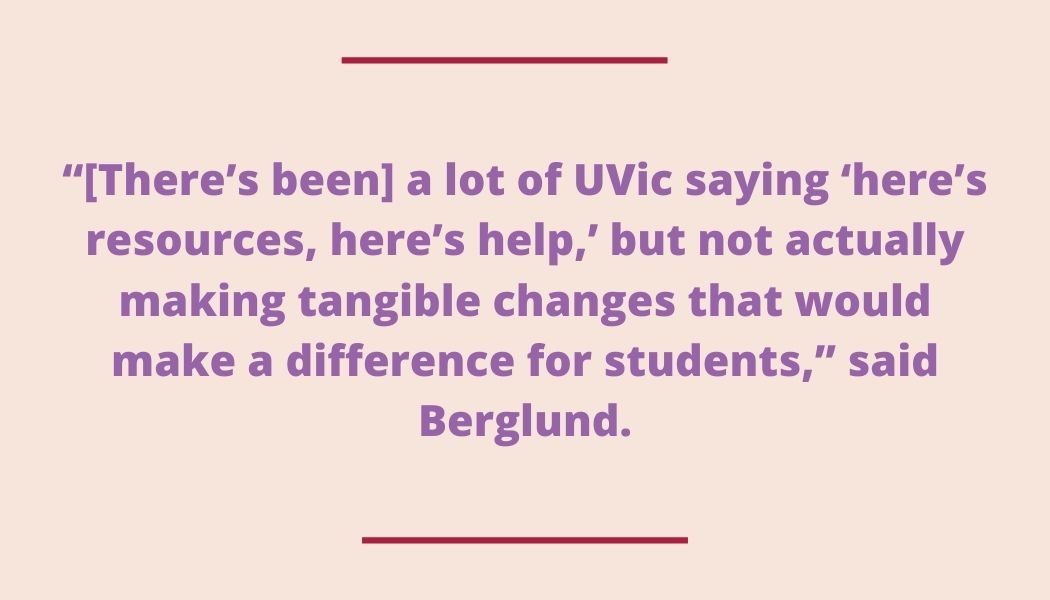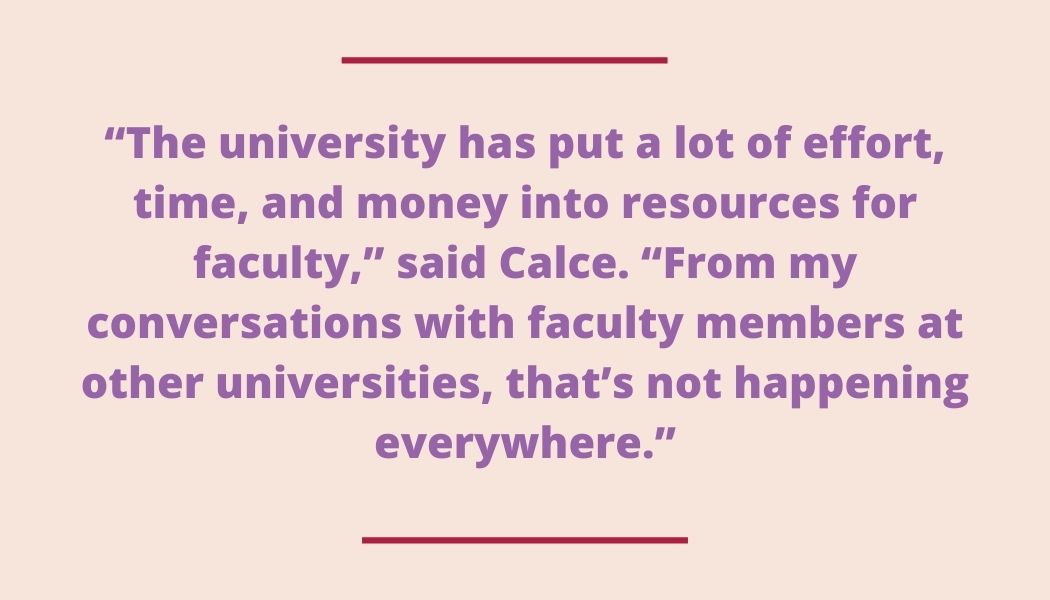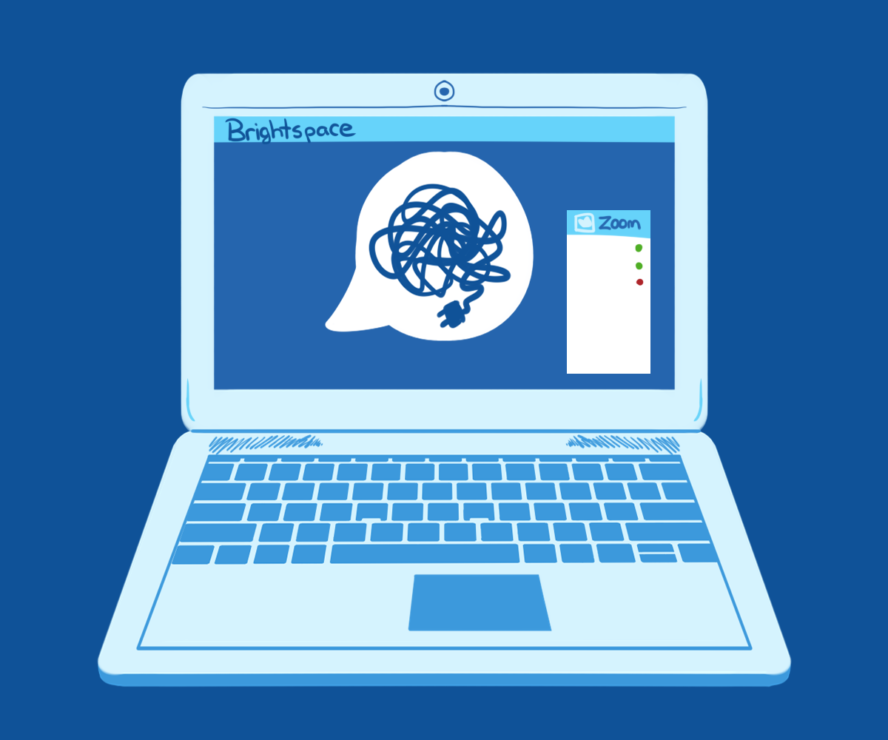The university has provided support, but students say it hasn’t been enough

UVic has cancelled class for snow days in the past, but the campus has never moved “predominantly online” for an entire academic year. The fall semester, in some ways, is the largest natural experiment in online learning ever conducted at the university. Ninety per cent of undergraduate classes are being delivered online.
While many instructors feel they’ve been adequately supported by UVic, some students believe that the university has fallen far short of its obligations.
It all began last March, when UVic joined other universities around the globe in moving online in response to COVID-19. UVic tried to adapt — they purchased a new learning management system, Brightspace, and created the Learn Anywhere and Teach Anywhere websites to direct students and instructors to resources.
UVic’s 2020 Student Guide to Online Learning states that some students find online classes to be “a better learning opportunity.” Students were skeptical about the transition to online — a Martlet survey of 400 students in May revealed that only 2.5 per cent of respondents believed online classes and in-person classes are the same quality — and for many, those concerns have persisted.
“It’s been overwhelming”: Students try to balance increased workloads
Rowan*, a professor in the social science faculty who wished to speak with the Martlet anonymously out of concern for their job and reputation, told the Martlet that several of their colleagues have said they see online classes as an easier way to teach. By posting recorded lectures and links to videos, instructors can shift some of the work from themselves to students.
Rowan said that their colleagues expressed a preference for online teaching methods so courses can be structured as more self-taught. This could explain why students are seeing heavier workloads — in some cases, they’re responsible for teaching themselves.
Marcus McDermand is a first-year French and mathematics student. He says he’s been learning from YouTube videos provided by his professors.
“The professors essentially handed us YouTube tutorials instead of actual lectures on the topic,” said McDermand. “I did not get a scholarship for $500 to have YouTube videos.”
For students like McDermand, this semester has brought on a heavier workload. In a poll of their members, the Economics Course Union (ECU) found that over 50 per cent of respondents are doing “a lot more work” this semester than in years past. 16.7 per cent of respondents spend over 60 hours a week on their courses, while 19.4 per cent spend between 40-50 hours per week.
Katy Berglund, a third-year political science and philosophy student, has also found her workload a lot higher than usual this semester. Beyond that, she’s found maintaining separation between school and the rest of her life to be challenging.
“My school weeks and my work time spreads out because I never feel like I’m done,” she said. “So, school spreads into the other corners of my life because I don’t have that clear separation from it.”
On top of individual courses being more work, Berglund has also been frustrated with the lack of standardization between classes across the university, saying the variation in how classes are run makes it difficult for her to switch between them.
“It’s been overwhelming,” said Berglund. “There’s definitely times when it feels like a lot and it’s really difficult to manage.”
To a point, the workload that students are facing might be in line with the university’s expectations. In the self-paced course about online learning created by UVic, 2020 Student Guide to Online Learning, the university writes that students should expect to spend between eight and 12 hours per week on their online classes. For a student taking four or five classes in a semester, that’s between 32 and 60 hours per week. Add in a part-time job and, by that metric, students are working vastly more than standard full-time hours, plus trying to care for themselves, have social lives, and meet any family responsibilities they might have.
Students’ mental health is also impacted by having fewer breaks, which some say has posed a challenge this year. Berglund also says the fall reading break felt like less of a break this semester than it has previously. Some of her professors put deadlines at the end of the reading break, meaning that she was unable to take a break from a semester she’s already finding to be more work.

According to Acting Vice-Provost Susan Lewis, the university is aware of workload challenges.
“Students (and instructors) have reached out to us with concerns over high workload in courses, and we are actively working with academic leaders and instructors to address and workload concerns through guidelines and best practices for online teaching,” said Lewis.
Lewis emphasized, on behalf of UVic, that instructors have significant autonomy in how they teach their classes, though the university has provided resources for online instruction.
“Faculty and instructors have the responsibility of designing and teaching their courses and there are a range of practices across campus and across disciplines,” said Lewis. “We also encourage instructors and faculty — early on in their courses — to reach out to students to see how they are doing and get feedback.”
While the university and instructors attempt to make changes to online classes, students are left trying to manage increased workloads.
Accessibility struggles
Some students have had their learning impacted more than others. Though the Centre for Accessible Learning (CAL) still provides access to certain accommodations virtually, it is closed for all in-person services due to COVID-19. CAL told students with disabilities that they are responsible for finding their own quiet space to write exams, which isn’t always attainable for students living with their families or roommates.
Before the onset of COVID-19, Jacob Macauley wrote exams in a quiet room at the CAL, where he had access to a university-provided computer. Macauley is a fourth-year honours student in the social sciences.
Macauley was told by CAL that he’s responsible for providing some of his accommodations himself, like access to a quiet space and a computer. But Macauley has found it challenging to make a quiet space to write exams in his family’s home, where he lives with his parents, four siblings, and a niece and nephew.
For Macauley, this has made online school even more difficult.
“It’s tough. It makes everything much more difficult. I’m much more stressed … I’ve noticed that I’m working a ton more,” he said.
Beyond struggling due to a lack of the accommodations he’s used to, Macauley has been frustrated by the communication to students with disabilities. He says that emails from CAL have been infrequent since the transition to online instruction and have predominantly communicated policy changes rather than facilitated dialogue with students.
Joel Lynn, executive director of student services, noted that, while testing has changed for all students due to COVID-19, the university still provides access to on-campus resources — though not through CAL.
“UVic has enhanced our laptop loan program and increased on-campus study space throughout the term,” said Lynn. “This includes computer workstations and adaptive technology rooms for use of accessibility software.”
Lewis emphasized that UVic is providing resources to instructors to support students with disabilities.
“We are in the process of putting specific resources into place for faculty and instructors that support teaching and assessment for students with disabilities in the online environment,” said Lewis.
Adapting to online classes
At the centre of the challenges students are facing with workloads and accessibility lies the structure of online classes themselves. In May, former president Jamie Cassels assured students that the quality of education would not change.
Instructors who spoke to the Martlet emphasized that there is no one-size-fits-all model of online instruction — some courses required far more adaptation than others.
One student, Zak*, is enrolled in a first-year course in fine arts. Zak requested to remain anonymous out of concern for his grades and reputation. All 200 students are in a two-hour synchronous Zoom call every week. With 200 people engaged in discussion for two hours in the Zoom chat, it tends to get “messy.”
“People were making jokes about being triggered in the chat [and] there were comments that were essentially denying patriarchy and other systems of oppression,” Zak said. “It’s on both the students and the professor … they had to threaten to close the chat if people weren’t being respectful.”
Other instructors have had fairly positive experiences with the online format, despite having to make significant changes. Katy Hind and Stephanie Calce are senior lab instructors for the Departments of Biology and Anthropology, respectively. They have both had to significantly shift how they teach their classes. Hind has filmed specimens and experiments in the lab for students to watch and assigned homework activities like documenting biodiversity, using a folding paper microscope, and calculating data. Calce has shifted her labs to focus more on written work and critical thinking.

Music professor Ajtony Csaba, who’s teaching orchestra this semester, has also made significant changes to his course. Though the course still involves some individual rehearsal, Csaba has focused on complementary material that will supplement the practical orchestral education that students will hopefully receive in the other years of their degrees.
History professor Kristin Semmens says that she has aimed to keep engagement levels high by holding synchronous classes while also posting recordings of the classes on Brightspace. Besides that, her classes have remained mostly the same. So far, she has been happy with the results.
“It’s been incredibly successful,” Semmens said. “I cannot believe the turnout factor, with the number of students who are committing to synchronous Zooming with me.”
Synchronous zoom classes can prevent challenges for international students to join, if they live in a different time zone. Hao Xi, a PhD candidate in comparative politics attending classes at UVic from China, has received plenty of support from his professors as well as from International Student Services at UVic.
He says that his professors have been sending him recordings of the seminars in case he can’t attend. He also says that International Student Services have been sending him a lot of helpful links to different supports and have offered international students help with things like study visas and travel permits in case they want to travel to Victoria for school.
Students struggling with mental health, some professors try to fill the gaps
As students face challenges of online classes like high workloads and the general stress of the COVID-19 pandemic, some are asking for more support from the university on mental health.
“I really feel like UVic has to do a bit more in terms of helping students with mental health,” said second-year humanities student Anik D. Spencer. “Everybody I’ve talked to is really struggling.”
Despite the opening of UVic’s new Student Wellness Centre and establishing the SupportConnect 24/7 mental health line, Spencer says that the advice given by counsellors often isn’t helpful.
“The advice is often the same, you know, it’s take some time to yourself and find some way to balance and take a breath,” Spencer said. “Which I mean, of course, this is great advice but when you’re in the middle of a pandemic, you’re struggling to pay rent, you’re having trouble if you aren’t going to classes — it just doesn’t feel like much.”
Rita Knodel, director of counselling and multifaith services at the Student Wellness Centre, emphasized that the university is providing mental health services at the same level as before the pandemic.
“We know that this is a difficult time for many people, and the pandemic has really increased stress and anxiety for many,” said Knodel. “Through the Student Wellness Centre, we are offering clinical counselling and health appointments mainly by phone, at the same levels as during typical operations.”
Some professors have taken it upon themselves to support their students’ mental health. Semmens says that she is making sure to check in with her students regularly and also, recognizing that not all students are comfortable sharing their mental health struggles in the public forum of a classroom, has been reaching out individually to students she is concerned about.
Sara Humphreys, a professor in the English department and the coordinator of ATWP 135: Academic Reading and Writing, says that she sees workload as a major hindrance on her students’ mental well-being and would like to see a lot of little assignments disappear.
“I think that that was one of the mistakes most of us made, is just giving too much work to students,” Humphreys said. “We have to meet provincial standards, so it’s like, how can we meet those standards and give students a break.”

Instructors satisfied with support from university
Despite the difficulties of adapting years of in-person instruction to online, most instructors approve of UVic’s support — though many of their students don’t feel the same.
Students and professors have access to a roughly similar set of resources provided by the university. For students, UVic created the Learn Anywhere website, which directs students to resources grouped in categories like academic supports, online tools, and well-being. Teach Anywhere, the equivalent site for instructors, appears similar but focuses on resources about how to create online classes.
Both students and professors have access to tech support drop-in sessions, workshops about online learning and teaching, and self-paced Brightspace materials.
However, some instructors say that the university gave them too many options and left them overwhelmed. Semmens says at one point in the term she was getting up to 10 emails per day about different programs that might make online instruction easier. Though she says that overall she applauds UVic’s efforts, Semmens almost wishes there was more of a consensus about the approach instructors should take.
“As much as I cling to the autonomy that is given to faculty in deciding how to teach, it felt very overwhelming that the world was our oyster, and we could do it however we chose,” said Semmens.
Besides support from UVic administration, instructors also receive assistance from their departments. Humphreys says that professors’ workloads have temporarily been decreased by teaching fewer sections and receiving more teaching assistant support.
“[Faculty] can say, look, I can’t teach this course of 500 people. I can’t teach three sections of this. I can do one online,” she said. “Okay, so you’ll owe us that two or three years down the line, but for now, we’re going to reduce your workload.”
Many of the instructors that the Martlet spoke to for this story spoke positively about the assistance they have been provided by UVic.
“The university has put a lot of effort, time, and money into resources for faculty,” said Calce. “From my conversations with faculty members at other universities, that’s not happening everywhere.”
Students ask for more support from UVic
While the professors the Martlet spoke to seem to be relatively happy with the direction the university has gone and with the support they are providing, students have made it clear that they expect more. On workloads, accessibility, and mental health, students are asking for more from UVic.
“[There’s been] a lot of UVic saying ‘here’s resources, here’s help,’ but not actually making tangible changes that would make a difference for students,” said Berglund. “UVic has a greater responsibility to students to be concerned about online classes and this experiment than just sending out a survey to do.”
As students say they are receiving insufficient support during online classes, two sources close to the university administration allege that UVic plans to increase online delivery after the pandemic.
Though UVic has not committed to adopting online delivery permanently, Lewis says that members of the university community have expressed an interest in additional online offerings.
“What we have heard [from instructors and students] is an interest in offering more flexible programming, including hybrid and blended courses with content delivered both online and in person,” she said.
Lewis emphasized, however, that in-person instruction will remain integral to UVic’s programs.
Spencer says that she would like to see the university step up with more resources and support. She says that she would also like to see UVic alleviate mental health stressors by lowering tuition and providing more study spaces.
“I know it always comes back to money, but money is a big struggle,” said Spencer. “Just provide more support, provide more resources, give people alternatives.”
Though individual students and instructors — and indeed the university itself — have different perspectives on whether UVic has done enough to provide support for online classes, many of them share concerns over mental health, workloads, and accessibility.
In November, the university sent out a survey to students asking about their experiences so far with online classes. Regardless of the results of the survey and how UVic chooses to respond, one thing is clear: students are facing a lot of demands while navigating online classes.
*Names have been changed to protect anonymity.






